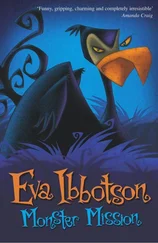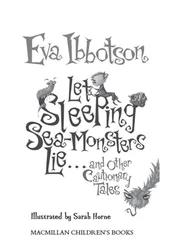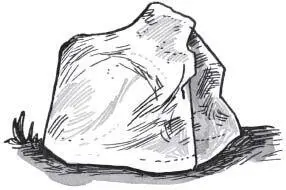
But sometimes — just sometimes — you might come across a rock that is not exactly what it seems. Such a rock will look strange and sinister and different.
A rock like that will be a Frid rock and inside it there will be a Frid .
What a Frid looks like is very hard to say because Frids never come out of their rocks, but what they do is nasty (as you shall see).
Once there was a Frid rock on a hill above a village in which there lived about two hundred people, some cows, some chickens, some pigs — and five dogs. All the people in this village were very careful not to upset the Frid. They spoke politely and quietly when they went near the rock and they put out crumbs by it and bowls of milk because crumbs and milk are a what Frids like. And the dogs were even more well behaved than the people, because an old story said that the last time a Frid had been angered it was by a dog and though no one could remember what had happened to the dog they knew that it was bad.


The five dogs in the village were friends.
There was an Old English sheepdog with wise eyes, which peered out under his grey and white fringe of hair. There was a liver-coloured spaniel who loved everybody and wanted everybody to love her, and spent a lot of time on her back with her legs in the air so that people could stroke or scratch her or even kick her if they wished. There was a basset hound with a body like a hairy drainpipe and ears that were full of little spiders and beetles which had climbed in as he trailed them along the ground. There was a poodle who had once belonged to a travelling circus. And there was a mongrel called Fred.
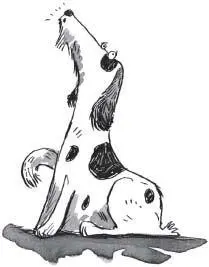
Every one of these dogs was a sensible dog. They knew that a Frid lived in the rock above their village and though they often went for walks together they took care to keep well away from the rock and if they did have to pass it, they did so quietly with their tails down. As for lifting their legs against anything within half a mile of the Frid rock, they would rather have died. Nor did the mongrel, though he was as tough as they came, ever make any jokes about a Fred not being afraid of a Frid because he knew that anyone who was not scared of a Frid was, quite simply, a fool.
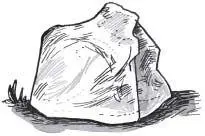
And so for many years the people and the dogs in the village lived in peace with the Frid and the Frid lived in peace with them, taking his crumbs and his milk at night and bothering no one.

Then one day a completely new dog arrived in the village. She came in a carriage with a rich and important lady who was staying in the inn and her name was Winsome Wilhelmina III of Bossybank Snootersloop, from which you will see that she was a pedigree dog and very, very grand. Winsome had long blonde hair, masses and masses of it. She had hair on her back which flowed down to the ground on either side. She had hair on her legs and hair rippling along her tail and hair on her head, where it was gathered into a topknot and tied with a pink satin ribbon. When Winsome Wilhelmina walked (which she didn’t very often because she preferred to be carried) she looked like a blonde wig on castors and all you could see apart from her hair were her snappy black eyes and her snooty black nose and, of course, her ribbon.
The other dogs saw her come and saw her carried into the inn, but they did not expect to see her again. She was obviously not the kind of dog who would mix with ordinary dogs like themselves. But it is no good being terribly grand and pure-bred and important if there is no one to see how grand and pure-bred and important you are and on the third day of her visit, Winsome Wilhelmina trotted out of the back door of the inn, found the five dogs lying in a patch of shade under a tree — and began at once to boast.
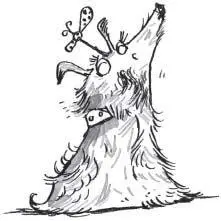
“I,” said the new dog, “am Winsome Wilhelmina. My pedigree goes back for nine hundred years. I sleep in a basket lined with white satin and it takes my mistress’s maid an hour to comb my hair.”
“Goodness!” said the sheepdog.
“I only eat the best steak cut into finger-thin slices, and peeled grapes for my bowels,” Winsome went on.
The other dogs had never seen grapes, let alone peeled grapes, but they were very impressed and the spaniel grovelled in the dust and licked Winsome Wilhelmina’s toes.
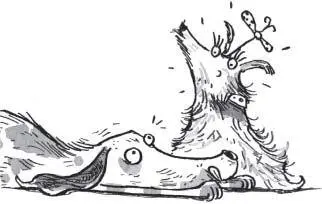
“There are real diamonds in my collar,” the little show-off continued. “You may look.”

So the dogs peered at Winsome’s neck and sure enough, buried deep in her silky, golden hair, was the sparkle of jewels.
By now the village dogs were quite overcome by the grandness of this newcomer. But Fred, the mongrel, plucked up his courage and said:
“Like to go for a walk with us, Win?”
Winsome Wilhelmina tossed her head. “I’d prefer you to use my full name if you don’t mind. But I don’t mind going for a walk as long as there’s no mud or dust to get in my hair.”
So they took Winsome Wilhelmina for a walk.
Because they did not want her to get her beautiful coat muddy they did not take her for their usual walk along the river where there were water rats to be chased, and because they did not want her to get dried leaves in her long silky hair they did not take her into the woods where there were pigeons to be terrified and holes to dig. Instead, they took her up the clean, straight, sandy path that led towards the Rock of the Frid.
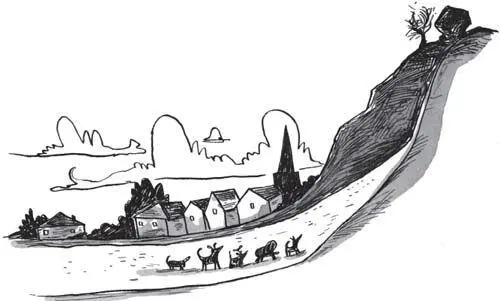
As they got closer to the rock, the village dogs got quieter and quieter but Winsome Wilhelmina didn’t.
“What on earth is that absolutely extraordinary rock?” she said in her high, upper-class-dog voice.
“It’s the Frid rock,” said the sheepdog.
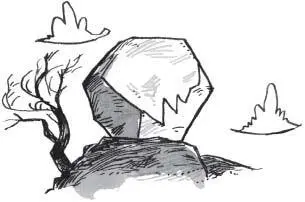
“It’s best to be quiet when we go past it,” said the basset hound.
“Quiet?” yapped Winsome piercingly. “Why should I be quiet because of some perfectly ridiculous rock? I’ve never even heard of a Frid. I don’t believe there is such a thing!”
“There is, Winsome,” said the sheepdog seriously. “There really is such a thing as a Frid and it’s inside that rock.”
“How do you know?” said Winsome, tossing her topknot.
Читать дальше














